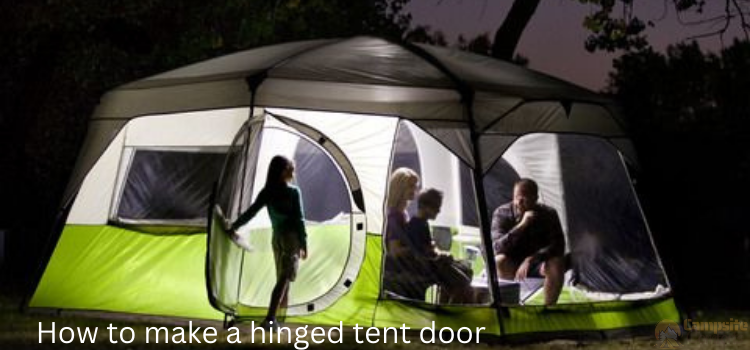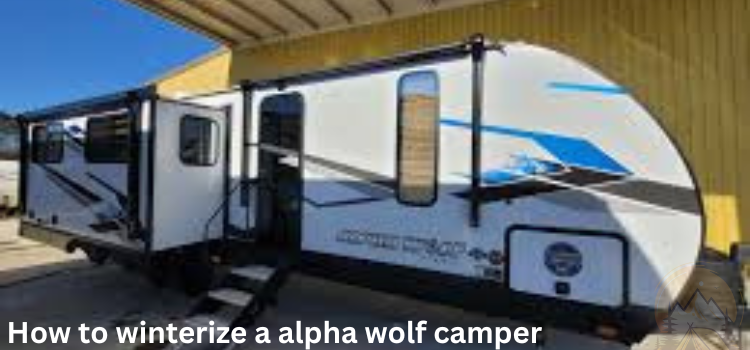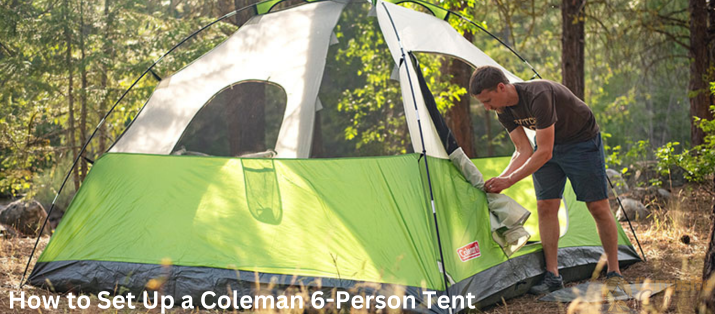When setting out on an outdoor adventure, whether it’s a camping trip in the wilderness or a weekend getaway in the mountains, having a reliable tent is essential. And at the heart of every tent lies its entrance door. While tent doors come in various styles, shapes, and designs, the hinged tent door stands out for its convenience, durability, and functionality. Unlike traditional zipper or flap closures, a hinged tent door offers ease of access and enhanced security, making it an indispensable feature for campers seeking comfort and convenience during their outdoor activity .
The importance of a hinged tent door becomes apparent when considering factors such as ease of entry and exit, especially during adverse weather conditions. Whether it’s rain, wind, or snow, a hinged door provides a sturdy barrier against the elements, keeping you and your belongings safe and dry inside the tent. Additionally, the hinged design eliminates the hassle of dealing with zippers or flaps, allowing for quick and effortless access to the tent’s interior. Moreover, hinged doors are known for their durability, with sturdy hinges and reinforced frames ensuring long-lasting performance even in rugged outdoor environments.
In this article, we will explore of how to make a hinged tent door of investing a tent equipped with a hinged door can significantly enhance your camping experience, offering convenience, protection, and peace of mind throughout your outdoor adventures.

why you should consider to making a hinged tent door:
When starting on outdoor adventures, every piece of equipment plays a important role in ensuring comfort, safety, and convenience. Among these essentials, the tent door holds particular significance, serving as the gateway to your temporary shelter in the wilderness. While traditional tent door closers like zippers or flaps are common, making a hinged tent door can offer several compelling benefits that enhance your camping experience.
First and foremost, a hinged tent door provides unparalleled ease of access. Unlike zippers that can snag or flaps that require careful maneuvering, a hinged door opens smoothly and effortlessly, allowing you to enter and exit your tent with minimal hassle. This convenience is especially valuable during nighttime trips to the bathroom or early morning outings, where fumbling with closures can be both frustrating and time-consuming.
Moreover, a hinged tent door offers superior durability and reliability. Constructed with sturdy materials and reinforced hinges, hinged doors are designed to withstand the rigors of outdoor use, including exposure to wind, rain, and other elements. This powerful construction not only ensures the longevity of your tent but also provides added security, keeping you protected from the elements and potential intruders while you rest inside your shelter.
Additionally, a hinged tent door contributes to enhanced ventilation and airflow within your tent. By allowing for partial opening at various angles, hinged doors facilitate better airflow compared to traditional closures, promoting a more comfortable sleeping environment, particularly on warm nights. This improved ventilation can help prevent condensation buildup and maintain a fresh, breathable atmosphere inside your tent, contributing to a more restful and enjoyable camping experience.
Materials needed for making a hinged tent door:
Crafting a hinged tent door requires careful consideration of the materials to ensure both functionality and durability. Here’s a comprehensive list of the essential materials you’ll need for this DIY project:
Wood or Aluminum Frame:
The foundation of your hinged tent door, the frame provides structural support and stability. Lightweight yet sturdy materials such as wood or aluminum, depending on your preference and desired durability.
Hinges:
Choose high-quality hinges capable of withstanding outdoor conditions and frequent use. Stainless steel or brass hinges are ideal choices, as they offer resistance and long-lasting performance.
Door Panel Material:
Select a suitable material for the door panel, considering factors such as weight, weather resistance, and insulation properties. Options include plywood, fiberglass, or lightweight composite materials designed for outdoor applications.
Latch or Lock Mechanism:
Ensure secure closure and easy operation by including a latch or lock mechanism in your design. Choose a strong locking mechanism that provides reliable security without compromising accessibility.
Sealing Material:
To prevent water leakage and drafts, you’ll need sealing material to create a tight seal around the door frame. Silicone caulk or weatherstripping can effectively seal gaps and ensure a snug fit between the door and frame.
Tools:
Gather basic tools such as a saw, drill, screwdriver, measuring tape, and sandpaper to cut, assemble, and finish the door components. Additionally, having a level and square on hand will help ensure specific position during installation.
Paint or Finish:
Apply a weather-resistant paint or finish to protect the door from moisture, UV exposure, and other environmental factors. Choose a color that complements your tent’s creative design while providing long-term protection against the elements.
Optional Accessories:
Depending on your preferences and specific requirements, you may also incorporate additional accessories such as handles, hinges, or decorative elements to customize the appearance and functionality of your hinged tent door.
By gathering these materials and following a carefully planned design, you can create a hinged tent door that not only enhances the accessibility and security of your shelter but also withstands the challenges of outdoor environments for years to come.
Step-by-step guide on how to make a hinged tent door:
By following these step-by-step instructions, you can create a basic hinged tent door that provides convenient access to your shelter while camping. With minimal materials and basic sewing or knot-tying skills, you can customize your tent with a functional door that enhances comfort and usability during outdoor adventures.
Measure and Cut the Fabric for the Door:
Begin by measuring the dimensions of the door opening on your tent. Use these measurements to cut a piece of sturdy fabric, such as canvas or nylon, to the appropriate size for your door panel. Make sure to leave a few extra inches of fabric on all sides to account for seams and hems.
Creating the Hinge Using Fabric or Rope:
To create a simple hinged mechanism, fold over one edge of the fabric door panel to form a flap. Then, sew or glue this flap securely along the edge of the door opening on your tent. Alternatively, you can use a length of strong rope or webbing to serve as a flexible hinge. Secure one end of the rope to the top edge of the door opening and the other end to the bottom edge, allowing the door to swing open and closed.
Attaching the Hinge to the Tent Frame:
With the fabric door panel or rope hinge in place, carefully attach the opposite side of the hinge to the tent frame. If using fabric, sew or glue the hinge securely to the frame along the corresponding edge of the door opening. For a rope hinge, you may need to tie or fasten the ends of the rope to the tent frame using sturdy knots or hardware such as grommets.
Adding a Latch or Closure Mechanism:
To ensure the door stays securely closed when not in use, add a latch or closure mechanism to your hinged tent door. Depending on your preference and available materials, options include simple hooks and loops, Velcro straps, or sliding bolts. Install the latch or closure mechanism near the center of the door panel, making sure it aligns with a corresponding attachment point on the tent frame when the door is closed.
Tips for customizing your hinged tent door:
Here are some tips to help you tailor your tent door to suit your preferences and needs:
Decorative Fabric:
Consider using colorful or patterned fabric to add a touch of style to your tent door. Choose a fabric that compliments your tent’s overall creative design and reflects your personality. Additionally, for durable, weather-resistant materials to ensure longevity.
Window Inserts:
Incorporating window inserts into your hinged tent door can enhance ventilation and natural light inside the tent. Choose clear vinyl or mesh fabric for the inserts to maintain visibility while keeping bugs and debris out. Customize the size and shape of the windows to suit your preferences.
Custom Hardware:
Upgrade the hardware on your hinged tent door for added functionality and visual appeal. Explore options such as decorative handles, knobs, or hinges in various finishes and styles to match your tent’s theme. Additionally, consider installing a magnetic closure for easy opening and closing of the door.
Integrated Storage Pockets:
Maximize space efficiency by sewing or attaching storage pockets directly to your hinged tent door. These pockets can hold small essentials such as keys, flashlights, or toiletries, keeping them easily accessible while minimizing clutter inside the tent.
Custom Screens or Netting:
If you’re camping in buggy or mosquito-prone areas, consider adding custom screens or netting to your hinged tent door. This allows you to enjoy fresh air while keeping insects out, enhancing comfort and relaxation during your outdoor adventures.
Reflective Elements:
Enhance safety and visibility by incorporating reflective elements into your hinged tent door design. Attach reflective strips or patches to the door panel to increase visibility at night, making it easier for fellow campers or emergency responders to locate your tent.
Modular Design Features:
Design your hinged tent door with modular features that allow for easy customization and adaptation to different camping scenarios. For example, you could create interchangeable panels for different seasons or weather conditions, such as a mesh panel for summer camping or a insulated panel for winter camping.
By incorporating these customization tips into your hinged tent door design, you can create a unique and functional entryway that enhances your camping experience and reflects your individual style preferences.
Benefits of having a hinged tent door:
Investing in a hinged tent door offers a multitude of advantages that can significantly enhance your camping experience. Here are some key benefits of opting for a hinged tent door over traditional closures:
Ease of Access:
One of the primary benefits of a hinged tent door is the ease of access it provides. Unlike zipper or flap closures that may require precise maneuvering, a hinged door opens smoothly and effortlessly, allowing for quick entry and exit from your tent.
Enhanced Security:
Hinged tent doors offer enhanced security compared to other closure methods. With a sturdy frame and reliable locking mechanism, hinged doors provide a robust barrier against intruders and unwanted wildlife, ensuring your safety and peace of mind while camping.
Improved Ventilation:
Hinged tent doors can contribute to better ventilation and airflow inside the tent. By allowing for partial opening at various angles, hinged doors facilitate the circulation of fresh air, preventing condensation buildup and maintaining a comfortable interior environment.
Durability and Longevity:
Designed to withstand the challenges of outdoor use, hinged tent doors are typically constructed from durable materials such as aluminum or reinforced fabric. This durability ensures that your tent door will withstand repeated use and exposure to harsh weather conditions, providing long-lasting performance season after season.
Convenience in Inclement Weather:
During adverse weather conditions such as rain or wind, hinged tent doors offer added convenience and protection. Unlike zippers that can become stuck or flaps that may flap open in the wind, hinged doors provide a secure seal, keeping you and your belongings dry and sheltered inside the tent.
Ease of Operation for All Ages:
Hinged tent doors are easy to operate for campers of all ages and abilities. Whether you’re a seasoned outdoor adventurer or a beginner camper, the simple push or pull action of a hinged door requires minimal effort, making it accessible to everyone in your camping group.
Customization Options:
Hinged tent doors offer different opportunities for customization to suit your specific needs and preferences. From choosing the material and color of the door panel to selecting decorative hardware and accessories, you can personalize your tent door to reflect your individual style and camping lifestyle.
The benefits of having a hinged tent door extend far beyond mere convenience. From improved accessibility and security to enhanced ventilation and durability, investing in a hinged door can elevate your camping experience and provide countless hours of enjoyment in the great outdoors.
Installation and Setup Instructions of making a hinged tent door:
Here is few steps and installation which you can easily follow to making a hinged tent doo:
Setting up a tent with a hinged door may seem difficult at first, but with the right guidance, it can be a straightforward process. Begin by laying out the tent and securing the corners with stakes to ensure stability. Next, assemble the tent poles according to the manufacturer’s instructions, taking care to insert them into the designated sleeves or clips.
When it comes to attaching the hinged door, make sure to align it properly with the tent frame before securing it in place. Most tents with hinged doors feature simple mechanisms for attaching the door, such as clips or Velcro straps. Take your time to ensure that the door is properly aligned and adjusted to prevent any issues later on.
Once the door is securely attached, double-check the overall alignment of the tent to ensure that everything is in place. Adjust the tension on the tent poles as needed to achieve a snug fit, and make sure that all guy lines are properly tensioned to prevent the tent from shifting in windy conditions.
In the event of any installation issues, refer to the troubleshooting section of the tent’s instruction manual for guidance. Common issues such as misaligned doors or difficulty in securing the tent may be easily resolved with a few simple adjustments. By following these installation and setup instructions, you can ensure that your tent with a hinged door is ready for your next outdoor adventure.
Alternatives to making your own hinged tent door:
While crafting your own hinged tent door can be a rewarding DIY project, there are alternative options available for campers seeking convenience or those without the time or resources for customization. Here are some alternatives to consider:
Pre-Made Tent Doors:
Many camping gear manufacturers offer tents with pre-made hinged doors as standard features. These ready-to-use doors come in various sizes, styles, and materials, allowing you to find a suitable option that meets your needs without the hassle of DIY construction. Simply select a tent model with a hinged door that aligns with your preferences and budget.
Aftermarket Door Upgrades:
If you already own a tent with a traditional zipper or flap door, you may be able to upgrade to a hinged door using aftermarket conversion kits. These kits typically include all the necessary components, such as hinges, hardware, and instructions for installation. By retrofitting your existing tent with a hinged door, you can enjoy the benefits of improved accessibility and durability without investing in a new tent.
Professional Customization Services:
For campers seeking a tailored solution or those with specific design requirements, professional customization services offer an alternative to DIY construction. Companies specializing in tent modifications can design and install custom hinged doors based on your specifications, ensuring a precise fit and seamless integration with your tent. While this option may involve additional cost, it provides the convenience of professional craftsmanship and expertise.
Temporary Door Solutions:
In situations where a permanent hinged door is impractical or unnecessary, campers can explore temporary door solutions for their tents. Options such as magnetic screen doors or roll-up fabric doors offer quick and easy access while providing protection from insects and the elements. These temporary door solutions are lightweight, portable, and versatile, making them ideal for camping trips where space and convenience are priorities.
DIY Modifications:
If making a hinged tent door from scratch seems daunting, consider exploring DIY modifications to enhance the functionality of your existing tent door. Simple alterations such as adding Velcro closures, reinforcing weak spots, or installing additional weatherproofing can improve the performance and durability of your tent door without requiring extensive construction or specialized tools.
By considering these alternatives to making your own hinged tent door, you can find a suitable solution that meets your camping needs and preferences while accommodating your skill level, budget, and time constraints. Whether you are making aa pre-made door, aftermarket upgrade, professional customization, temporary solution, or DIY modification, enhancing the accessibility and functionality of your tent door can significantly enhance your outdoor camping experience.
Conclusion:
Making a hinged tent door is a simple and practical solution for any camper or outdoor activities. By following these steps, you can easily create your own customized tent door that will provide convenience and functionality during your camping trips. Whether it’s to keep bugs out or add some extra ventilation, this DIY project is worth trying out on your next outdoor adventure. So gather your materials and get ready to enjoy the benefits of a hinged tent door.
FAQS:
What are the disadvantages of hinged doors?
However, hinged doors also have certain disadvantages. They must be broad enough to accommodate the door’s swing while opening, and they can be challenging to open and close if not properly balanced. They also frequently need regular repair.
Which hinges are best for doors?
The most common kind of hinge for mounting a standard door is a butt hinge. There are removable and non-removable pins included with these hinges. The advantage of loose pin systems is that you can remove the door without taking the hinge apart. In situations when a floor covering could obstruct the door, use a rising butt hinge.
Can a door have 2 hinges?
One lightweight door with a hollow core might be able to get away with utilizing just two hinges. Nevertheless, you cannot use fewer than three hinges at the very least if you are working with an external or solid-core door.






